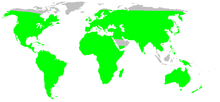Philodromidae
Philodromidae, also known as philodromid crab spiders and running crab spiders, is a family of araneomorph spiders first described by Tord Tamerlan Teodor Thorell in 1870.[1] It contains over 600 species in thirty genera. Most are dull colored- brown, gray, yellowish or mottled with a leaf-like cardiac mark on the anterior dorsal abdomen, and seldom reach above 10 millimetres (0.39 in) long. None of the species build webs, but they do use silk for draglines and egg sacs.
| Running crab spiders | |
|---|---|
 | |
| Philodromus sp. | |
 | |
| Running crab spider | |
| Scientific classification | |
| Kingdom: | Animalia |
| Phylum: | Arthropoda |
| Subphylum: | Chelicerata |
| Class: | Arachnida |
| Order: | Araneae |
| Infraorder: | Araneomorphae |
| Family: | Philodromidae Thorell, 1870 |
| Diversity | |
| 30 genera, 648 species | |
 | |
It is superficially similar to the "true" crab spiders, but these families are not as closely related as previously thought.[2] Philodromids tend to have few true setae (hairs or spines) on their bodies and lack the congruent eye tubercles of some crab spiders. Their second legs are usually the longer of the four pairs of walking legs. It is most evident in Ebo, where the second pair of legs are twice as long as the first pair in some species.
The most common genus is Philodromus which is widespread, similar to Ebo.[3] Other common genera include the elongate grass-dwelling Tibellus and the widespread Thanatus, which includes the house crab spider that commonly captures flies on and in buildings.[4]
Genera
As of April 2019, the World Spider Catalog accepts the following genera:[3]
- Apollophanes O. Pickard-Cambridge, 1898 — North America, Asia, Trinidad, Panama, Ecuador
- Bacillocnemis Mello-Leitão, 1938 — Argentina
- Berlandiella Mello-Leitão, 1929 — Brazil, Argentina
- Cleocnemis Simon, 1886 — South America
- Ebo Keyserling, 1884 — Asia, North America, Argentina
- Eminella Özdikmen, 2007 — Argentina
- Fageia Mello-Leitão, 1929 — Brazil
- Gephyrellula Strand, 1932 — Brazil
- Gephyrina Simon, 1895 — South America, Saint Vincent and the Grenadines
- Gephyrota Strand, 1932 — Asia, Africa, Australia
- Halodromus Muster, 2009 — Spain, Asia, Africa
- Hirriusa Strand, 1932 — Namibia, South Africa
- Metacleocnemis Mello-Leitão, 1929 — Brazil
- Pagiopalus Simon, 1900 — Hawaii
- Paracleocnemis Schiapelli & Gerschman, 1942 — Argentina
- Pedinopistha Karsch, 1880 — Hawaii
- Petrichus Simon, 1886 — South America
- Philodromops Mello-Leitão, 1943 — Brazil
- Philodromus Walckenaer, 1826 — North America, Asia, Africa, Oceania, Europe, Caribbean, Central America, Venezuela
- Procleocnemis Mello-Leitão, 1929 — Brazil
- Psellonus Simon, 1897 — India
- Pseudopsellonus Balogh, 1936 — Papua New Guinea
- Pulchellodromus Wunderlich, 2012 — Algeria, Europe, Asia
- Rhysodromus Schick, 1965 — Asia, North America
- Suemus Simon, 1895 — Sierra Leone, Vietnam, South Africa
- Thanatus C. L. Koch, 1837 — Africa, Asia, North America, Europe, South America
- Tibellus Simon, 1875 — North America, Asia, Africa, South America, Cuba, Italy, Australia
- Tibitanus Simon, 1907 — Namibia, Guinea-Bissau, Guinea
- Titanebo Gertsch, 1933 — United States, Mexico
- Vacchellia Caporiacco, 1935 — Karakorum
incertae sedis
- Euthanatus Petrunkevitch, 1950 † (fossil)
- Filiolella Petrunkevitch, 1955 † (fossil)
- Medela Petrunkevitch, 1942 † (fossil)
See also
References
- Thorell, T. (1870). "On European spiders". Nova Acta Regiae Societatis Scientiarum Upsaliensis. 3 (7): 109–242.
- Homann, H. (1975). "Die Stellung der Thomisidae und der Philodromidae im System der Araneae (Chelicerata, Arachnida)". Zeitschrift für Morphologie der Tiere. 80 (3): 181–202. doi:10.1007/BF00285652.
- "Family: Philodromidae Thorell, 1870". World Spider Catalog. Natural History Museum Bern. Retrieved 2019-04-23.
- Kulczyński, W. (1903). "Aranearum et Opilionum species in insula Creta a comite Dre Carolo Attems collectae". Bulletin International de l'Academie des Sciences de Cracovie. 1903: 50.
External links
| Wikispecies has information related to Philodromidae |
| Wikimedia Commons has media related to Philodromidae. |